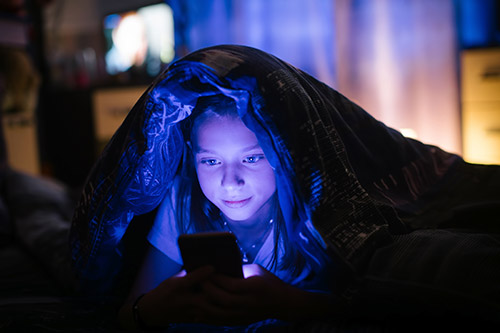
We all do it — one last scroll before bed. But what feels harmless can quietly disrupt your sleep and strain your eyes.
At Evolutionary Eye Care, we’re seeing more patients with symptoms tied not to daytime screens, but to nighttime screen exposure.
Here’s how blue light affects your vision, sleep, and overall eye wellness — and what you can do to minimize the damage.
What Is Blue Light — and Why It Matters More at Night
Blue light is high-energy visible (HEV) light emitted by digital devices, LED lighting, and the sun.
During the day, it helps regulate alertness and mood.
At night, though, it confuses your brain, suppressing melatonin — the hormone that signals sleep — and overworking your eyes in low-light environments.
This leads to:
Eye strain and fatigue
Dryness and headaches
Disrupted sleep cycles
Reduced night vision clarity
How Blue Light Disrupts the Eye’s Natural Clock
Your eyes and brain operate on a 24-hour rhythm known as the circadian cycle.
When exposed to bright blue light after sunset, the brain interprets it as daylight and delays melatonin release.
This not only causes sleep deprivation, but also reduces overnight tear regeneration — one reason your eyes may feel dry or irritated in the morning.
💡 Did you know? Even two hours of screen exposure before bed can delay melatonin production by up to 23%.
Impact on Retinal and Macular Health
Emerging research suggests chronic exposure to artificial blue light may contribute to oxidative stress in the retina — the same process linked to macular degeneration over time.
While screens don’t emit enough intensity to cause direct damage, the cumulative effect of nightly exposure adds up, especially when combined with poor lighting habits.
The Double Effect: Eye Strain + Sleep Debt
The combination of visual fatigue and poor sleep sets up a feedback loop:
Less rest means slower tear film recovery.
Dry eyes become more sensitive to light.
You blink less when tired, increasing strain.
You compensate with more screen brightness — worsening the cycle.
At Evolutionary Eye Care, we call this “Digital Sleep-Eye Syndrome” — a modern vision-health issue that goes beyond simple screen strain.
Protecting Your Eyes from Blue Light at Night
You don’t need to ditch your phone — just manage your exposure smartly.
✅ Use “Night Mode” or blue light filters after sunset.
✅ Dim brightness instead of relying on full contrast in dark rooms.
✅ Take 20-20-20 breaks: every 20 minutes, look 20 feet away for 20 seconds.
✅ Blink consciously to keep your tear film hydrated.
✅ Wear blue light–blocking lenses if you work late.
Bonus: Try amber lighting in your bedroom — it mimics evening firelight and supports melatonin release.
Best Practices for Nighttime Digital Hygiene
To reduce strain and support better sleep:
🌙 Turn off screens at least 60 minutes before bed.
🌙 Keep screens below eye level to reduce lid exposure and dryness.
🌙 Maintain room lighting when using screens — avoid pitch-black contrast.
🌙 Hydrate and use preservative-free artificial tears before sleep.
Simple, sustainable changes can drastically improve both visual comfort and sleep quality.
When to See an Optometrist
If you notice:
Blurry vision at night
Redness or burning after screen use
Trouble falling asleep despite fatigue
…it’s time for a professional eye evaluation.
At Evolutionary Eye Care, we use blue-light sensitivity testing and tear film analysis to identify whether light exposure is affecting your ocular surface or sleep patterns.









